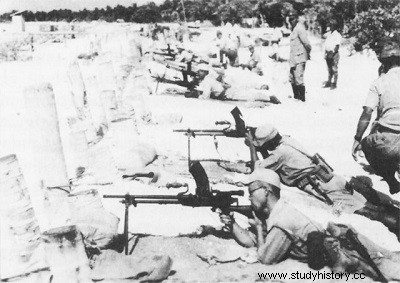
The supplies followed, drop by drop, brought by a detachment of pioneers and reinforcements arrived, under the relative protection of the long pier. The courage of these men was exceptional; the Japanese couldn't stop them!
This endless day gave way to an endless night, illuminated by the glow of the fires of the petrol depots. It was during the night that the Japanese lost their last chance to drive the marines back to sea. There was no counterattack. The bombardment had destroyed the transmissions and Admiral Shibasaki could not make contact with his men to launch them all together on the two tiny bridgeheads held by the Americans. On November 21, the tide was fatal to the enemy garrison. A battalion of the 8th Marines came ashore and, after spending an exhausting night being tossed about in the boats, was in turn subjected to the inferno of the Japanese. At the western end of Betio, a battalion from the corps reserve, provided by Admiral Turner, was able to gain a foothold and come to relieve the small detachment which was trying to hold the "beak" of the bird. Howitzers had been landed; they began firing as the destroyers' guns adjusted their fire with precision on the targets in the most dangerous areas.
Rushing through a hail of bullets, two companies of marines managed to reach the shore on the side of the ocean and entrenched themselves there; other units headed for the field, still swept by enemy fire, which stretched between the runways of the airfield. All the western part of Betio was cleared, which made it possible, on November 22, to land another battalion of the 6th Marines. The third day of the battle was painful but the death knell of the defense sounded definitively from the moment when the marines succeeded in demolishing or blocking the most important of the works which had not ceased to resist since D-Day. The Japanese, in a hopeless situation, nevertheless continued the fight. By nightfall only a few isolated outposts remained on the ground captured by the Americans and three battalions of the 2nd Marine Division had pushed back to the eastern part of the island (the "tail"). what remained of the Japanese.
Finally, the Japanese counter-attacked. They were about 500 who burst out of the bush and encountered a deluge of fire from a destroyer and artillery. They continued anyway until they came into contact, with bayonets and grenades, with a company of marines. The engagement was fierce, but the result was a foregone conclusion:the Japanese collapsed en masse, hit by shrapnel or killed in the Marine trenches. In the morning, the 2nd Division cleared the ground definitively, annihilating the last defenders by the combined action of tanks and infantry. General Smith announced that Betio had fallen, November 23, at 1:12 p.m. The total American losses at Tarawa had been very high, but to the Japanese they were frightening. Only 146 prisoners were counted, and still for the most part, Korean workers. All the rest of the garrison, initially 4,836 strong, had been wiped out. The figures given by the 2nd Division show that 984 men of the marines and the fleet paid with their lives for the capture of Betio, but it was more than 1,000 that had to be counted when all the reports had been examined. To this figure must be added 2,072 injured.
Jorge Pérez Troya He was born in Torre de Juan Abad (Ciudad Real) in 1916. At the age of 20 he was involved in the Civil War , fought in the Alcázar de Toledo, in the Alto de los Leones, in Guadarrama and in Jarama (as a sergeant and in charge of an anti-aircraft battery). After the end of the
